
About UsThe Numismatic Bibliomania Society is a non-profit organization promoting numismatic literature. For more information please see our web site at coinbooks.org SubscriptionsThose wishing to become new E-Sylum subscribers (or wishing to Unsubscribe) can go to the following web page link MembershipThere is a membership application available on the web site Membership Application To join, print the application and return it with your check to the address printed on the application. Membership is only $15 to addresses in the U.S., $20 for First Class mail, and $25 elsewhere. For those without web access, write to: David M. Sundman, Treasurer AsylumFor Asylum mailing address changes and other membership questions, contact David at this email address: dsundman@LittletonCoin.com SubmissionsTo submit items for publication in The E-Sylum, just Reply to this message, or write to the Editor at this address: whomren@gmail.com
BUY THE BOOK BEFORE THE COIN |
- WAYNE'S WORDS: THE E-SYLUM FEBRUARY 9, 2014
- LAKE BOOKS SALE #117 PRICES REALIZED AVAILABLE
- KREINDLER LIBRARY PART II SALE CLOSES FEBRUARY 13, 2014
- NEW BOOK: GRADING GUIDE FOR EARLY AMERICAN COPPER COINS
- NEW BOOK: THE ISLAND STANDARD: COINAGES OF PAROS
- FROM A THANKFUL NATION: LATIN AMERICAN MEDALS
- TOKEN PUBLISHING’S YEARBOOKS GO DIGITAL
- JOURNAL OF ANCIENT NUMISMATICS TO RESUME PUBLICATION
- LOUIS VAN BELKUM 1942-2013
- NOTES FROM E-SYLUM READERS: FEBRUARY 9, 2014
- INTERVIEW: E-SYLUM EDITOR WAYNE HOMREN
- JOHN BURNS AND THE BRAZILIAN COMMEMORATIVE BARS
- MORE REMEMBRANCES OF JOHN H. BURNS
- UPDATE ON THE JOHN H. BURNS MEMORIAL FUND
- MORE WHITMAN COIN IMAGE PRINTING PLATES
- THE LIFE AND WORK OF ANTHONY DE FRANCISCI
- ON THE LEGALITY OF OWNING ALUMINUM CENTS
- JOHN KLEEBERG ON THE NON-COLLECTIBLE DESIGNATION
- QUERY: IMAGE OF 1881 SWISS 20 CENTIME SOUGHT
- FILM: GOLD FEVER AND THE BECHTLER MINT
- HARVEY STACK REMEMBERS COLLECTORS DENNIS AND SAMUEL WOLFSON
- CANADIAN POLICE SEIZE U.S. BANKNOTE COUNTERFEITING PRESS
- DICK JOHNSON ON SLABBING HISTORICAL MEDALS
- BRITISH COUNTERMARKED U.S DOLLARS
- W.L. WARING TOKEN DATED TO EARLY 1860S
- THE AMERICAN LEGION SCHOOL AWARDS
- TURKEY COUNTERSTAMP ON A FRANKLIN HALF DOLLAR
- HERITAGE TO SELL RUTH HILL BANKNOTES
- MONEY ARTIST BRAD TROEMEL EXHIBITION
- FEATURED WEB PAGE: UNITED STATES ASSAY COMMISSION MEDALS
Click here to access the complete archive
To comment or submit articles, reply to whomren@gmail.com
WAYNE'S WORDS: THE E-SYLUM FEBRUARY 9, 2014

New subscribers this week include John Jackson, courtesy of Mark Tomasko, Len Cicero, courtesy of Russ Sears, Bob Fagaly, courtesy of Bill Eckberg, Grant Hansen, and Dennis Fuoss. Welcome aboard! We have 1,697 email subscribers.
This week we open with notes from literature dealers Fred Lake and David Fanning, followed by two new books and a new exhibition catalog. Other topics include author Louis Van Belkum, collectors Dennis and Samuel Wolfson, the Bechtler Mint, and the Ruth Hill banknote collection.
To learn more about the new grading guide for early American copper coins, Latin American Medals, Brazilian commemorative bars, and the superior intellect of medal collectors, read on. Have a great week, everyone!
Wayne Homren
Editor, The E-Sylum
LAKE BOOKS SALE #117 PRICES REALIZED AVAILABLE
Lake Books has posted the prices realized list for its mail-bid sale of numismatic literature #117 which closed on February 4, 2014 on its web site at www.lakebooks.com/current.html Results were very strong for hardbound sale catalogs, especially those from George Kolbe with prices earning three to four times estimate in many cases. United States material from the 19th century also garnered top prices. Fred Lake announced that their next sale will have a closing date in late April, 2014 and will feature selections from the libraries of J. H. Cline and Harry Warren. Good Luck with your bidding, Fred.
Lake Books
PMB 118
6822 22nd Ave. N
St. Petersburg, FL 33710-3918
727-343-8055 FAX: 727-381-6822
KREINDLER LIBRARY PART II SALE CLOSES FEBRUARY 13, 2014
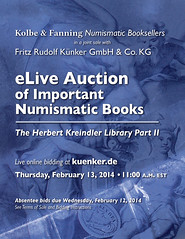 Kolbe & Fanning Numismatic Booksellers wish to remind their clients that the second part of the outstanding and comprehensive library on ancient numismatics formed by New York coin dealer Herbert Kreindler will be offered in a joint sale with Fritz Rudolf Künker GmbH, of Osnabrück, Germany.
Kolbe & Fanning Numismatic Booksellers wish to remind their clients that the second part of the outstanding and comprehensive library on ancient numismatics formed by New York coin dealer Herbert Kreindler will be offered in a joint sale with Fritz Rudolf Künker GmbH, of Osnabrück, Germany.
The sale will be an online-only eLive auction held on Thursday, February 13, 2014 starting at 11:00 AM Eastern Time.
Live online bidding and virtual lot viewing is available at kuenker.de.
Absentee bids may be placed by contacting Kolbe & Fanning and MUST be placed by Wednesday, February 12.
Register for online bidding at elive-auction.de.
View lots (numismatic literature lots start with lot 4001) at: elive-auction.de/auktion?o=%2Fauktion%2Flose%3Fcategory%3D8160 .
Download the PDF catalogue at numislit.com/numislit/images/pdfs/133eLive.pdf .
Please note that the online sale will be conducted in euros. The estimates in the Kolbe & Fanning version of the printed catalogue are expressed in dollars for the convenience of their U.S. bidders. Absentee bids can be accepted in either currency.
For more information, see the Kolbe & Fanning website at www.numislit.com or email David Fanning at df@numislit.com. Please note that Kolbe & Fanning staff will not be available to answer questions during the sale itself.
NEW BOOK: GRADING GUIDE FOR EARLY AMERICAN COPPER COINS
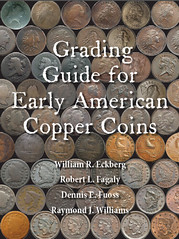 Early American Coppers, Inc. (EAC) is pleased to announce the upcoming publication of its first book, the new Grading Guide For Early American Copper Coins. This profusely illustrated, 192-page hardcover book fully describes the process of grading early American copper coins as practiced by collectors who specialize in them. It will become available to members at the EAC convention in Colorado Springs, CO, May 1-4, 2014 and to the public immediately thereafter.
Early American Coppers, Inc. (EAC) is pleased to announce the upcoming publication of its first book, the new Grading Guide For Early American Copper Coins. This profusely illustrated, 192-page hardcover book fully describes the process of grading early American copper coins as practiced by collectors who specialize in them. It will become available to members at the EAC convention in Colorado Springs, CO, May 1-4, 2014 and to the public immediately thereafter.
The cover price will be $54.95 plus $5 P&H. EAC or C4 members in good standing will get a $5 discount. Members purchasing the book at the EAC convention will pay only $45. All proceeds from the book will go to EAC to support its educational and outreach activities.
Because copper coins were the money of the people and (unlike gold coins) were heavily used in commerce, because they are heavy and soft, and because copper is more reactive to oxidation than silver or gold, they received more wear and damage than early gold and silver coins. Because their relative value did not fluctuate like that of gold and silver coins, they were less subject to mass meltings during their time of circulation. Thus, many stayed in circulation until they were unrecognizable due to wear or corrosion. Yet, because these coins were the money of the fledgling United States, and because the insults that plagued them add to their charm, the collectors of early copper are among the most dedicated and involved in all of numismatics.
Nevertheless, the different grading standards early copper specialists use from the commercial standards in the rest of US numismatics, and the different way they account for damage to coins from that used by the rest of numismatics adds an extra level of complexity and concern for those who might wish to collect these endlessly fascinating coins. This book addresses that complexity and concern by thoroughly describing the grading standards and processes used by specialists in the field and comparing them to the commercial standards and processes used in the rest of numismatics, with the goal of making copper collecting easier, more enjoyable and more fulfilling for all.
Grades from About Good to Mint State (and higher Mint State grades, where such coins exist) of nearly all series are illustrated by full color photos twice the diameter of the coin. Most of the images have been taken, with permission, from the auction lot archives of Ira and Larry Goldberg, Auctioneers, Heritage Auctions and Stacks-Bowers Galleries.
The book addresses each of the different types of half cents and large cents individually. Earlier grading guides have lumped together several half cent and large cent head styles with substantially different wear patterns, causing confusion that this guide avoids. Liberty Cap half cent and cent grading standards are illustrated and discussed by date, as are two distinct head styles each of Chain, Draped Bust and Braided Hair cents, and four head styles of Coronet cents. Of particular importance, there is an illustrated explanation of the differences between the traditional technical sharpness standards used in EAC and those used commercially.
No other guide provides as much information about grading the Confederation era coinages. A chapter is devoted to standards for grading Confederation era state copper coins (Connecticut, Vermont and New Jersey coppers and Massachusetts cents and half cents) and Fugio cents.
In addition, about 20 pages are devoted to fully explaining and clearly describing the unique and supposedly mysterious process of “net grading” used by specialists to account for post-striking damage in determining a grade. Since defects impact the grade of higher-grade coins more severely, net grading is described for each sharpness grade from Good to Mint State. Large color photos identify the defects that lead to the net grade.

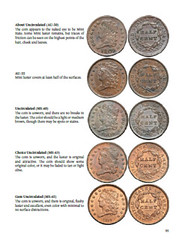
Its chapters also directly address the history of the grading of early coppers, the differences between technical and market grading, authentication, the handling and preservation of early coppers, and factors other than grade that affect value. EAC members have discussed producing such a guide ever since the second meeting of the club in 1969, so it can be said that this book has been 45 years in the making. The authors have worked for two years to produce it. For anyone with an interest in the first coins of the United States, and especially for anyone who wants to learn to grade these coins as well as a professional, and thereby find the greatest possible value in early copper coins, this book is indispensable.
An order form can be downloaded at: http://eacs.org/Book%20Invoice.pdf
A full-page ad can be downloaded at: http://eacs.org/Grading%20Guide%20ad.pdf
For additional information including ordering for resale, please contact halfcent@mac.com.
Bim Gander, President, Early American Coppers
One might legitimately ask why a coin club like EAC needs its own grading standards. On the surface, the very idea smacks of exclusivity, like some fraternal handshake to be shared only by the snobbish brethren of some secret society...
The question is eloquently answered in this superb new book by Messrs. Eckberg, Fagaly, Fuoss, and Williams. To be sure, EAC grading has been around for a long time, but the concept of net grading has likely been applied in as many ways as there are members of the club. A major contribution of this volume is that it provides standardization with color photography and the judicious selection of those coins which best illustrate the technical EAC grades for every early copper design. Even more important are the dozens of photographs of where EAC damage evaluation is applied: the essence of “net grading.”
Without a doubt, the ability to evaluate a coin’s post-production damage, and its impact on value, is an essential skill for all collectors. It is especially important for the connoisseurs of our early copper denominations, where even some low grade examples are highly prized.
Denis Loring, large cent expert and charter member of EAC
“At last! The mystery of EAC grading, that arcane process used by alleged “copper weenies” and the dealers who love them, is finally revealed. This comprehensive, profusely illustrated guide presents the what, the why, and – most important – the how of EAC grading, detailed by type, date and even die variety. Of particular interest is a textual and pictorial comparison with grading by PCGS and NGC. This long-awaited book is immediately an indispensable reference for anyone interested in the early copper coins of the United States.”
J. R. (Bob) Grellman, Jr. , cataloguer of copper coins for Ira and Larry Goldberg, Auctioneers
Where was this book when I needed it over 50 years ago? It would have saved me from so many bad decisions when buying early coppers. While no book alone can be an adequate substitute for experience, the authors have done a remarkable job simplifying the very complicated subject of “EAC Grading.” Grading disagreements will not disappear, of course, but at least this book can help focus our thinking on the matter. I am proud to have been a part of this landmark project.
Mark Borckardt, Senior Cataloguer, Heritage Auctioneers and Galleries
Since joining Early American Coppers (EAC) 40 years ago, I have developed a thorough understanding of early copper grading. Today, I provide all of the EAC style grades for half cents and large cents that appear in my company’s auctions. However, when asked to explain how I arrive at those grades, I am unable to comply. The topic is that complex. The authors of the Grading Guide for Early American Copper Coins have accomplished what I never could. They explain EAC style grading for half cents and large cents, and even include Colonial coins. Not only do they explain EAC style grading, they teach the reader how to grade by those standards. Every early copper collector needs to understand EAC grading. Every early copper collector needs this book.
Q. David Bowers, Chairman Emeritus, Stacks-Bowers Galleries
I have been following the evolution of EAC grading for many years. I congratulate the authors for their discussion of issues such as luster, porosity, and the importance of various defects at various grade levels. Taken together, these considerations yield an EAC grade that represents old-time conservatism and tradition. Put another way, I can bank on an EAC EF-40, for example, being a very nice EF-40, whereas a commercially-graded EF-40 can range anywhere from desirable, to a coin I would never want to own. Beyond that, the authors – and the leaders of EAC – are to be commended for encouraging their members to study their coins carefully, which adds greatly to the pleasure of ownership.
James L. Halperin, Co-Founder of Heritage Auctions and author of How to Grade U.S. Coins
An insightful and incredibly useful guide for anyone who wants to learn how to grade copper coinage like a specialist. It’s about time that someone finally wrote this book. Impressive!
EMPLOYMENT OPPORTUNITY!
Live and Work in Southern CaliforniaStack’s Bowers Galleries offers an important employment opportunity for the right person. We are seeking an experienced numismatist in the American series—coins, tokens, medals, and paper money—to work with our “dream team” of catalogers, building on the tradition of the Ford, Eliasberg, Bass, Cardinal, Norweb, Battle Born and other great collections.
If you can write in an authoritative and compelling manner with a high degree of accuracy, this may be just right for you! You will be working in Irvine, a modern community in dynamic Orange County, California—one of the finest areas to live. We offer generous benefits including medical and dental coverage, 401K plan, and more. Our offices are in our own modern, state-of-the art building with all amenities.
If you would like to be considered for this position please contact Q. David Bowers by mail or by email with your resumé, samples of your past writing (on numismatics or other subjects), and salary requirements: Mail to the attention of Q. David Bowers, PO Box 1804, Wolfeboro, NH 03894. Email to: Ckarstedt@stacksbowers.com
NEW BOOK: THE ISLAND STANDARD: COINAGES OF PAROS
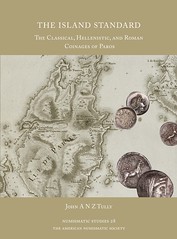 The Island Standard: The Classical, Hellenistic, and Roman Coinages of Paros (Numismatic Studies Volume 28)
The Island Standard: The Classical, Hellenistic, and Roman Coinages of Paros (Numismatic Studies Volume 28)
by John A.N.Z Tully
List price: US$120
ISSN 051-7404-x
ISBN 978-0-89722-329-4
Hardcover, 250 pages
This book is the first comprehensive study of the monetary history of one of the major coin-producing states of the Hellenistic and Roman Aegean. It analyzes the Classical, Hellenistic, and Roman coinages of the Cycladic island of Paros. It presents a die study of all known silver and bronze issues, and argues that Paros and its neighbor Naxos minted in the Hellenistic Period not on the Rhodian standard as has sometimes been thought, but on their own distinct standard: the ‘island standard’. All coin types are fully described, and die varieties are illustrated in 27 plates.
John Tully read Greats at Magdalen College, Oxford before moving to Harvard, then Princeton, where he finished his PhD dissertation on “Networks, Hegemony, and Multipolarity in the Hellenistic Cyclades” in 2012. In 2010, he took the Eric P. Newman Graduate Seminar in Numismatics at the ANS in New York; this book is a direct result of the project he started there. He is currently a consultant in New York.
For more information, or to order, see:
The Island Standard: The Classical, Hellenistic, and Roman Coinages of Paros (Numismatic Studies Volume 28)
(numismatics.org/Store/TheIslandStandardTheClassical
HellenisticAndRomanCoinagesOfParos)
FROM A THANKFUL NATION: LATIN AMERICAN MEDALS
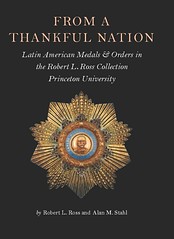 Spectacular Exhibition of Latin American Medals Opens at Princeton University Library
Spectacular Exhibition of Latin American Medals Opens at Princeton University Library
In celebration of the two-hundredth anniversary of Latin America’s wars of independence, the Princeton University Library has mounted a dramatic display of medals and orders that illustrate the recognitions awarded to soldiers and civilians in the form of wearable insignia. “From a Thankful Nation” opens on Tuesday, February 25, in the Main Exhibition Gallery of Firestone Library on the Princeton campus.
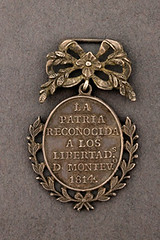 The exhibition features hundreds of Latin American decorations, ranging from a plain silver medal awarded to an officer of the Buenos Aires armed forces that freed Montevideo from Spanish colonial rule in 1814, to Guatemala’s highest award given to foreign presidents, the Collar of the Order of the Quetzal with its Mayan motifs, to a gilt example of the Cuban Order of Che Guevara, awarded for assistance to Latin America’s many left-wing movements of national liberation. Unlike the United States, which has generally avoided the award and wearing of medals as a vestige of European royal practice, the Spanish-, Portuguese-, and French-speaking nations of the New World have embraced such displays as tangible expressions of appreciation for the efforts of their soldiers and citizens.
The exhibition features hundreds of Latin American decorations, ranging from a plain silver medal awarded to an officer of the Buenos Aires armed forces that freed Montevideo from Spanish colonial rule in 1814, to Guatemala’s highest award given to foreign presidents, the Collar of the Order of the Quetzal with its Mayan motifs, to a gilt example of the Cuban Order of Che Guevara, awarded for assistance to Latin America’s many left-wing movements of national liberation. Unlike the United States, which has generally avoided the award and wearing of medals as a vestige of European royal practice, the Spanish-, Portuguese-, and French-speaking nations of the New World have embraced such displays as tangible expressions of appreciation for the efforts of their soldiers and citizens.
Miguel Angel Centeno, Professor of Sociology and International Affairs and Chair of Princeton’s Department of Sociology, writes in his introduction to the exhibition catalogue, “These medals and orders allow us a unique perspective on the development of Latin American states and the qualities they have chosen to represent and reward.” On Sunday, April 13, at 3 p.m., Professor Centeno will give a public lecture on the ideals exemplified by the pieces in the exhibition. The lecture in McCormick Hall 101 will be preceded by a curatorial tour of the exhibition at 1:30 p.m. and followed by a reception in the Main Gallery. Additional curatorial tours will take place on Friday, February 28, and Thursday, May 29, at 3 p.m.
The exhibition is based on the collection assembled by Robert L. Ross, a retired investment banker who worked throughout his career to improve living standards in Latin America as the best way to promote democratic rule and civil society. Ross has donated his medals to the Princeton University Numismatic Collection for study, research, and teaching purposes in support of the University’s Program in Latin American Studies. This gift has made Princeton’s holdings the world’s most comprehensive collection of Latin American orders and medals.
 “From a Thankful Nation” traces the development of Latin American medals from their origins in the emblems of medieval crusading knights and the Spanish, Portuguese, and French royal and imperial orders through the revolutionary battles and the building of republics throughout the region. The use of medals as part of the governing strategies of dictatorial caudillos and adventuring “filibusters” is illustrated by such pieces as the pearl-adorned example of the Grand Cross badge of the Juan Pablo Duarte Order of the Dominican Republic that the dictator Rafael Trujillo, as grand master of the order, awarded to himself. While tracing the awards to common soldiers and laborers, the exhibition is most eye-catching with the display of no fewer than ten examples of Collars, the highest grade of an order (usually reserved for heads of state), as well as seventy Grand Cross sets, most replete with brightly colored silk sashes enameled gilt badges, and breast stars.
“From a Thankful Nation” traces the development of Latin American medals from their origins in the emblems of medieval crusading knights and the Spanish, Portuguese, and French royal and imperial orders through the revolutionary battles and the building of republics throughout the region. The use of medals as part of the governing strategies of dictatorial caudillos and adventuring “filibusters” is illustrated by such pieces as the pearl-adorned example of the Grand Cross badge of the Juan Pablo Duarte Order of the Dominican Republic that the dictator Rafael Trujillo, as grand master of the order, awarded to himself. While tracing the awards to common soldiers and laborers, the exhibition is most eye-catching with the display of no fewer than ten examples of Collars, the highest grade of an order (usually reserved for heads of state), as well as seventy Grand Cross sets, most replete with brightly colored silk sashes enameled gilt badges, and breast stars.
The exhibition is accompanied by a full-color catalogue written by Ross and Princeton’s Curator of Numismatics, Alan Stahl. In 736 pages of text and with 969 color photographs, it sets all of the official medals of each country in their historical context. The catalogue is for sale from the Library for $125; inquiries should be directed to loliveir@princeton.edu. The exhibition is also documented in a fully illustrated website: rbsc.princeton.edu/thankful-nation/ .
“From a Thankful Nation” runs from February 25 through August 3 and is open to the public without charge on weekdays from 9 a.m. to 5 p.m. and on Saturdays and Sundays from noon to 5 p.m. Further information is available from Princeton’s Curator of Numismatics, Alan Stahl, astahl@princeton.edu , (609) 258-9127.
TOKEN PUBLISHING’S YEARBOOKS GO DIGITAL
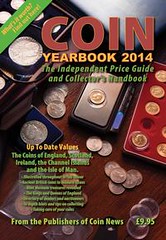 The Coin Yearbook 2014, Medal Yearbook 2014 & Banknote Yearbook 8th Edition, are now available in digital format. Token Publishing Ltd publishes the magazines Coin News and Medal News every month and have been producing Yearbooks for over 20 years.
The Coin Yearbook 2014, Medal Yearbook 2014 & Banknote Yearbook 8th Edition, are now available in digital format. Token Publishing Ltd publishes the magazines Coin News and Medal News every month and have been producing Yearbooks for over 20 years.
- The Banknote Yearbook details, in full colour, every English, Scottish, Irish and Island (Jersey, Guernsey, IOM) banknote since the turn of the 20th century – now in its 8th edition.
- The 2014 Coin Yearbook, the 21st edition, is THE handbook for dealers and collectors alike, it lists every British coin since Celtic times in an easy to read format giving you instant access to the information – no confusing numismatic terms here – this book is 100% useful and 0% baffling.
- The Medal Yearbook is world renowned – now in its 20th edition the 2014 yearbook lists every official British medal ever issued (and some unofficial ones) as well as those of Ireland and the Commonwealth dominions of Canada, Australia, New Zealand and South Africa. Every medal is illustrated in full colour, with an up to date valuation and a breakdown of when it was awarded, why and to whom! An essential book.
In addition to the printed versions, these books are now available as a digital download from the Token Publishing website.
You can purchase them online and access them through ‘My Account’ ‘Digital Downloads’. You can download the books or view them online. They are suitable for computers, mobile devices & most tablets, so you can read them on your tablet, smart phone for computer device, on the go or at home.
To vist the Token Publishing website, see: www.tokenpublishing.com

JOURNAL OF ANCIENT NUMISMATICS TO RESUME PUBLICATION

The Journal of Ancient Numismatics (JAN) is a free online journal dedicated to the study of Ancient and Medieval numismatics and history. I am very pleased to announce that thanks to the generous sponsorship of Agora Auctions we will begin publishing again! The Journal now has a new website where you can access all of the old issues and where new issues will be posted: http://coinproject.com/jan
The Journal will be published electronically every quarter starting some time in March and all members of the Agora Auctions mailing list will be notified. We are always looking for good article submissions. If you have an article you would like to submit please contact us.
As many of you know, JAN started out as a newsletter of my numismatic business. If you are receiving this announcement it is because at one point you were either a customer of mine or you had signed up for my mailing list via my blog or the JAN website.
I have been blessed with the support of many friends and colleagues. Thanks to you projects such as Coin Project, the Journal of Ancient Numismatics and Agora Auctions have been possible.
LOUIS VAN BELKUM 1942-2013
 The birth of the modern era of national bank note collecting can be definitively fixed at 1968 when Louis Van Belkum's landmark National Banks of the Note Issuing Period, 1863-1935 was published.
The birth of the modern era of national bank note collecting can be definitively fixed at 1968 when Louis Van Belkum's landmark National Banks of the Note Issuing Period, 1863-1935 was published.
This book, which summarized the history of every note-issuing bank, also listed the final circulations for the banks. The information in the book was abstracted from the endless tables found in 67 annual reports of the Comptroller of the Currency.
It became an instant buyer's guide for those of us chasing nationals, and was so successful it was reprinted in 1973. For the first time, we had some idea of what was out there and how much it totaled.
But that was only the beginning of this man's monumental contribution to national bank note research. Over the next 11 years, from 1968 to 1979, he and his wife Barbara compiled the bank-by-bank issuance data for every note-issuing bank in the country.
This Herculean task at last count involved tracking 12,631 different banks that issued 81,259 different sheet combinations over a period of 67 years. To compile this enormous trove of data, they had to sift through 410 huge ledgers housed at the National Archives, which were then located in Washington, DC, but now in College Park, Maryland.
This benchmark achievement quantified national bank notes. We now knew exactly what was issued and how many by every bank in the country. The modern era of national bank note collecting now rested on a bedrock solid foundation. All else that has followed is window dressing.
At the time, Louis was a school teacher in Grand Rapids, Michigan. He and Barbara would undertake marathon driving trips to DC, whereupon they wrote frantically and doggedly eventually assemble some 5,000 type-written pages of data. The National Currency and Bond Ledgers that they scoured still yield his pull slips dating from that period.
This work was carried out for individual state collectors who would contract with him to compile information on a state or county basis at a fixed charge per bank. As the program gained momentum, the data was traded around and accumulated by both John Hickman and Lyn Knight.
In time, Hickman convinced William Higgins of the Higgins National Bank Note Museum in Okoboji, Iowa, of the merits of these data, so after all other avenues were tapped out, Higgins sprang for the orphan states so Louis could complete the job.
The data became widely available in 1981 with publication of Don Kelly's National Bank Notes, a guide with prices followed by the Hickman-Oakes Standard Catalog of National Bank Notes, in 1982.
Along the way, in 1970, Louis collaborated with M. Owen Warns and Peter Huntoon to produce the blue book of 1929 nationals, The National Bank Notes Issues of 1929-1935.
Van Belkum is known by us as Louis or Lou; however, within his family he went by Bill. He was born Louis William Van Belkum III in Grand Rapids, Michigan. His odyssey into national bank notes started when he began collecting Michigan nationals in 1964. He sold most of his collection in 1976 through a Donlon auction, but the last of his Michigan holdings came out a few years ago.
He and Barbara moved to Las Vegas and once there he got heavily involved in collecting casino chips.
Lou succumbed July 31, 2013, to Alzheimer's disease at age 70, in Grand Rapids, to which he and Barbara returned a few years ago. He is survived by Barbara, his wife of 50 years, and his children Sandra, Paula and Louis William IV.
Van Belkum's compilation of national bank note issuance data probably ranks as the largest single block of numismatic research ever undertaken by an individual and will forever loft him to the highest ranks of numismatic researchers. Every national bank note collector is in his debt.
NOTES FROM E-SYLUM READERS: FEBRUARY 9, 2014
On Handling Coin Slabs Alan Weinberg writes:
The unusual and welcome variation in exhibiting and handling the Tettenhorst half cents was that each slab was isolated and protected by a manila paper "sleeve" so that the slabs would not scuff up against each other and obscure the half cent's condition and detail. This was not done with the Walt Husak large cents or, I believe, the Holmes large cents and there were negative comments made about this seeming lack of care. Good to see that public demand was not ignored. I wish our governments would be so responsive.
To read the earlier E-Sylum article, see: BILL ECKBERG'S MISSOURI CABINET DIARY (www.coinbooks.org/esylum_v17n05a13.html)
ANS Library Duplicate Available for Pick-Up In the February 2014 ANS Enews, the American Numismatic Society announced:
The ANS Library has a reprint copy of the Bibliographie der deutschen Zeitschriften-literatur to give away. Interested individuals must arrange for pick-up, although library staff can be available to help with the loading process (There are over 100 volumes, so it would take a car or multiple trips to pick it up). If you are interested, please contact Elizabeth Hahn Benge at hahn@numismatics.org or by phone: 212-571-4470, ext. 170.
Mark Twain and the Million Pound Bank Note Dave Ginsburg writes:
Great edition of The E-Sylum, as usual, but. . . How is it you can mention the million pound bank note and not mention Mark Twain?
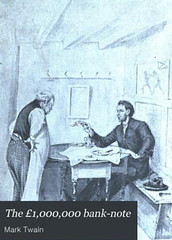 To read the complete Wikipedia article, see:
The Million Pound Bank Note
(en.wikipedia.org/wiki/The_Million_Pound_Bank_Note)
To read the complete Wikipedia article, see:
The Million Pound Bank Note
(en.wikipedia.org/wiki/The_Million_Pound_Bank_Note)
To read the complete story on Google Books, see:
The £1,000,000 Bank-note, and Other New Stories
(books.google.com/books?id=O1YPAAAAYAAJ&dq=
intitle%3Aother%20intitle%3Anew%20intitle%3Astories%20inauthor%3
Atwain&pg=PP1#v=onepage&q&f=false)
To read the earlier E-Sylum articles, see:
THE BANK OF ENGLAND £1M AND £100M BANK NOTES
(www.coinbooks.org/esylum_v17n05a19.html)
THE MILLION POUND BANK NOTE, OR "GOT CHANGE FOR THAT?"
(www.coinbooks.org/esylum_v06n09a09.html)
MILLION POUND NOTES
MARK TWAIN'S THE £1,000,000 BANK-NOTE
(www.coinbooks.org/esylum_v16n05a24.html)
Query: Kazakhstan Golden Warrior Coin Image Sought Via Arthur Shippee, Adrienne Mayor, Stanford Classics Department writes:
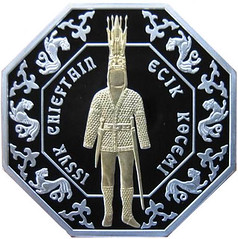 For my forthcoming book, The Amazons: Lives and Legends of Warrior Women across the Ancient World (Princeton Univ. Press), I am looking for a high resolution image of this coin (300 dpi would be ideal). ). I will be happy to acknowledge your help and give credit in the book.
For my forthcoming book, The Amazons: Lives and Legends of Warrior Women across the Ancient World (Princeton Univ. Press), I am looking for a high resolution image of this coin (300 dpi would be ideal). ). I will be happy to acknowledge your help and give credit in the book.
Arthur Shippee adds:
This is a Kazakhstan coin depicting the Golden Warrior (Chieftain) of Issyk, issued in 2011, I believe. is there an international association of coin clubs, which might have a connection to Kazakh collectors?
INTERVIEW: E-SYLUM EDITOR WAYNE HOMREN
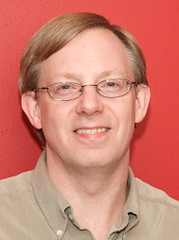 Q: This is traditionally the very first question we ask on every interview. Please tell us a little bit about how you developed interest in numismatics. Was there someone or something of significance that played a role?
Q: This is traditionally the very first question we ask on every interview. Please tell us a little bit about how you developed interest in numismatics. Was there someone or something of significance that played a role?
Like most Baby-Boomer collectors, I started out filling Whitman folders with Lincoln Cents. But I can pinpoint when my interest grew – it was July 1969 and I was 10 years old and sick as a dog. I got in the mail a package I’d ordered from Littleton Coin Company full of foreign coins on approval. I spent a couple days in bed looking through them and began collecting foreign coins by country. My grandfather later gave me a box of foreign coins from his side of the family. But the biggest event was meeting Glenn Mooney in 1978. He was a member of the Western Pennsylvania Numismatic Society and a volunteer curator at the Carnegie Museum of Pittsburgh. He sponsored me for membership in WPNS, and he and all the members became numismatic role models and mentors for me.
Q: For those readers not familiar with The Numismatic Bibliomania Society (NBS), please tell us a little bit about its organizational mission and how you first got involved.
The club web site states its mission very well: “The Numismatic Bibliomania Society (NBS) is an educational organization founded in 1979 to support and promote the use and collecting of numismatic literature. Numismatic literature includes books, periodicals, catalogs and other written or printed material relating to coins, medals, tokens, or paper money, ancient or modern, U.S. or worldwide.”
My involvement started about that time NBS was being organized. I attended a presentation by John J. Ford Jr. at an American Numismatic Association convention, and what he said about the value of numismatic literature really resonated with me. I think I signed up for NBS at that convention. Now I’m a Life Member.
Q: Your immediate responsibility at NBS is getting a weekly issue of The E-Sylum out to nearly 1,700 readers. What does it take to put together one issue?
Well, I’ve gotten pretty efficient at it, so it takes less time than many people think. Some actually assume it’s my full time job. Each issue has as many or more articles than Coin World, so that’s understandable. But as a compendium of information from readers and other publications, the amount of writing I do is relatively small in comparison. It’s about eight hours of work on average per week, spread out across seven days. I start a draft of the next issue on Monday or Tuesday, and daily before bed and before leaving for work I check my email for submissions and news stories of interest. By Friday I have an outline with three to five stories complete, and an email folder of acceptable ideas. I plow thorough one email after another until the issue is complete, which often takes me right up to publishing time, about 9:30 Sunday evening. I press the button to publish the issue and call it a night.
Q: How do you see The Numismatic Bibliomania Society evolving over the next 20 years? More international interest? Influx on younger collectors through digital exposure?
We’ve always had a subset of international members in NBS. The E-Sylum has broadened that exposure considerably, but I’m not sure that’s translated into many paid international members. But that’s OK. We’re very happy to provide The E-Sylum free in order to promote NBS and the numismatic hobby in general.
As for younger collectors, I think E-Sylum has helped in that regard. I regularly include invitations to join NBS, and the club has gotten quite a few new members over the years. Many -Sylum are younger – even some in high school. I have to tone down my jokes sometimes for a family audience.
I guess I don’t see things changing considerably in the next twenty years. The younger collectors of today will become the greybeards of tomorrow, then a new generation will filter in, just as previous generations did.
Q: Please tell us a little bit about your own coin collection. What are your areas of interest?
My own specialty is the numismatics of the U.S. Civil War, although I sold much of my collection through American Numismatic Rarities in 2006. I had Encased Postage Stamps, Postage Stamp Envelopes, Confederate currency, Civil War Tokens and a restrike Confederate half Dollar. The sale also included my. U.S. Merchant counterstamp collection. I still collect, but have fewer specialties. Two favorites are Carnegie Hero Medals and Labor Exchange currency. Of course, I also have my numismatic library of about 3,000 volumes.
Q: Many of our readers are just starting their coin collections. In your opinion, what are the five must-read books for every collector?
First, let me state that while I have 3,000 coin books, I haven’t read them all – not cover-to-cover, anyway. That’s because most coin books are reference books – you use them when you want to look something up. Far fewer coin books are the kind you really sit down and read. That’s what makes them special. Here are some favorites from that category:
- In Yankee Doodle’s Pocket, by Will Nipper (on Colonial coinage)
- Fractional Money, by Neil Carothers
- Renaissance of American Coinage by Roger Burdette (3 volumes)
- Million Dollar Nickels, by Montgomery, Borchardt, Knight
- Coins and Collectors, by Q. David Bowers
To read the complete article, see: Interview: Wayne Homren (blog.coinsupplyplanet.com/interview-wayne-homren/)
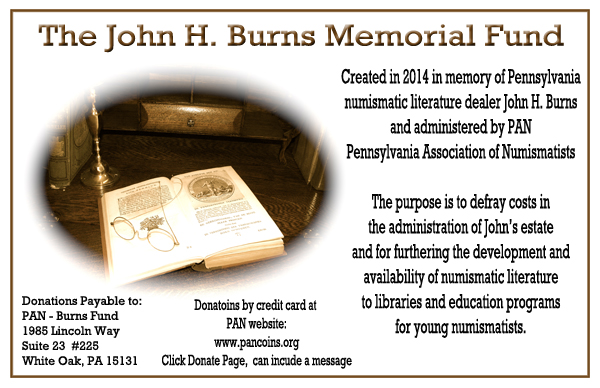
JOHN BURNS AND THE BRAZILIAN COMMEMORATIVE BARS
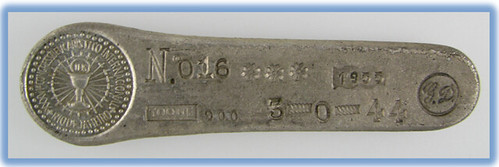

For years I was building a collection with the goal of mounting what proved to be an award-winning exhibit, entitled "Off the Beaten Numismatic Path." It comprised over 100 items several of which were either one of a kind or unknown to even advanced collectors. Examples included the engraved gold medal awarded to the winner of the very first spelling bee in Pittsburgh in 1908 and an 1898 wooden "made from" of the USS Olympia.
When purchases were made at coin shows where John Burns was set up, I'd have fun showing them to him and musing together over their significance and provenance. Whenever I located a piece of which I had no previous knowledge, it became a ritual to test John on his knowledge of it. And of course he always knew more than either I or the dealer who sold it to me did. But at the 2008 World's Fair of Money in Baltimore "I had him!"
I walked over to his table with my latest prize in hand. Although looking like a silver ingot, it was issued for the International Eucharistic Congress held in Rio De Janeiro in 1955. It is number 16 of a mintage of only 45. I sat down next to him and said, "John, get ready to be stumped…I've got something here that even you can't identify." I pulled it out, stuck it in front of his eyes, and before I could take a breath he snapped, "Brazilian Bar!" in a voice and with a look that added, "Can't you make it tougher than that?"
Beaten by the best!
MORE REMEMBRANCES OF JOHN H. BURNS
Celene writes:
John H. Burns, please remember the H with the (period.) as someone else had the same e-mail, but without the period John had once told me. Even the printer that made John’s business cards forgot the period after the H and John hand wrote on each of them the (.).
John was a great friend of mine and I will miss him terribly and not one coin show will ever be the same without seeing him in the back corner or the back of some coin hall set up with his wooden crates of books stacked high upon his tables. If you knew John this moment was inevitable and you wanted to ignore the future possibilities that one day John would no longer be with us anymore. It has taken me some time to really want to put anything in print as it would seem that the news of John’s death was finally reality and fact, not just some coin gossip spread amongst the show floor or sites.
You could not be John’s friend and not really worry about his health or the effect of the loss of his parents. John was shook at the loss of his Dad, but when his Mom’s health was failing and she needed care, it took a great chunk of John's heart and the biggest piece seemed to go as well at her passing.
I felt fortunate by John’s calls, of him checking in and seeing how life was treating me, our talks about just nonsense, the weather, a movie, music (hard rock of course), what girl he was interested in this week and hugged him, what he was going to be making for dinner or who he’d had dinner with at a show, his pride in being Scottish, a good bottle of Scotch or Wine, his collection of Porcelain Notgeld, how he did not like cats or his great love of his parents.
If John was your friend you knew it, he made the effort. Not just someone you ran into at a show or two and maybe had dinner with on occasion, but someone who genuinely cared when the show was over. Someone really hit it on the head when they wrote, if John was your friend, he really was your friend and if you had a problem or a problem with someone, so did John.
I have great fond memories of John and most of them do not have anything to do with Numismatics or Numismatic Literature, except for maybe the hauling of his books to his van lovingly named “Shamu” and then finally replaced with “Baby Shamu” and that when the show was over there was life beyond, even though it was hard to not talk about something to do with the show, the people or a good book.
One very funny memory for me was shoving John into the front seat of Rich Mantia’s little Black Honda Civic after a CICF show, because John had never been to Wrigley Field and how Rich had insisted how can you come all this way, be so close to Chicago and not go, so we did. John had a great time. We went to so many famous Chicago spots that John finally said, “Are we going to stop for Dinner now?” Taco’s it was. John not only ate his, but finished mine.
My son Spencer wanted to add a note of Thanks as well to John for allowing him the chance to work his first ANA show at the age of 9 years old, which was held at the Stephens Convention Center in Rosemont this past year as a Dealer, badge and all for the week. It was an experience that he relishes and will never forget, a moment and memory that will add to this very young Numismatist forever. Much thanks to John and Nancy Wilson, for posting the picture of John, myself, my son Spencer and Rich Mantia (my son’s God Father).
John H. Burns, you will be and are greatly missed and remembered.
Rich Mantia writes:
It has taken some time to compose my thoughts and emotions regarding the passing of John Burns. I now find myself able to do so and that this is the best forum for being able to convey them. I could certainly compose a eulogy for him, but this is not the time or place for that.
John H. Burns, John Burns, Big John or John as people invariably knew him was a unique person unto each of us. John Burns was and is my friend! How lucky am I that I can make that claim. I was John’s friend, but I was more fortunate in that he was mine. John was friend to many people and they as well to him, however in the larger picture he was a friend to even those who never met him. It would be too easy to describe John as a book dealer, a bibliophile or as a coin person and he was far more than a movie or trivia buff. John was a man, a Scottish man who happened to be proud to be an American man. He was obviously large physically, which concerned many of us that knew him, because we cared about him and didn’t want to lose him to health concerns, but we all knew John was John and that he did as he pleased. It can be fairly stated that John had immense appetites, for life, for friendships, for conversation, for sharing knowledge and yes for women.
John possessed something that seems to be a rarity in this day. He possessed integrity, virtue, honesty and a lack of greed. Those of us that met and knew John were able to do so at coin shows, but only those shows that he attended. He was a numismatic book dealer as we tend to characterize him, but he only sold books as a means to meet people and share knowledge. Setting up his bookstall at coin shows to which he could travel was how he earned an income, but he didn’t actively sell books at those shows. He paid the bills and earned enough to subsist until the next coin show or if a collection large or small was offered to him to purchase. He didn’t make serious efforts to sell or grow his business, he made serious efforts to share himself with others doing what he liked in life. Books were just a way for John to meet people and gain more friends.
That’s where his wealth was located in his friends and the lives he touched. John’s booth was the place to meet others and where knowledge and gossip was shared freely. It was an oasis of civility in a room filled with greed and avarice where knowledge and enjoyment of a hobby took precedence. John was the barometer for business, if he spoke well of you to others then you were acceptable, but if he spoke negatively you probably deserved it.
Unknowingly and arguably, John sold more coins than books and every dealer that ever coexisted with John at a show benefited by his presence. John’s inventory was such that it was all encompassing for anyone’s collecting topic and priced so that it would sell. When dealers daily struggle to sell their wares to an ignorant public, he struggled even harder to sell the same public the books about their interest. Sold those books he did, through the force of his likeable personality and when he sold a book a collector would gradually become a numismatist and would buy those coins from the dealers in the room. Coin dealers made profits because John Burns made it happen, show after show, year after year. He did so much to advance the hobby and business and he made very little monetarily speaking to show for it, but he made friends.
John Burns was and is my friend! How lucky am I.
I could continue to write about the endless adventures and tales of John, they are innumerable, awe inspiring and enviable. He is gone forever in body, but not in the hearts and minds of those that he touched. Gone too soon, leaving the lament and loss of his friends grieving and trying to find a way to cope. We will go on, but without John … words escape me.
Thank you to John and Nancy Wilson, for posting the photo of myself, my friend Celene and her son Spencer with John at the August 2013 A.N.A. convention here in Rosemont, Illinois. It is our last picture together though mischaracterized as Rich Mantia and family, we considered ourselves as part of John’s family. I had the pleasure of unloading “Baby Shamu” and setting up his booth at the show with his wooden crates, but I also had the pleasure to help him sell his books during the show and at the end I packed up his books and reloaded “Baby Shamu” with him only supervising me. I was sweating profusely after moving thousands of pounds and John was worried about me, little did he know I was worried about him and I didn’t want him to exert himself because I cared about him and looked forward to seeing him again.
I won’t see him again and I miss him.
Thank you John for being my friend!
Kerry Wetterstrom writes:
John Henry Burns used to call me about twice a week, and I miss those phone calls. I didn't find out about JK's memorial ad in Coin World until after it was published, but John did an excellent job, as have you and Pat McBride.
Just for clarification purposes, Nick Economopoulos is an ancient coin dealer from Doylestown, PA, and one of the owners of Pegasi Coins, based in Ann Arbor, MI. He is real, and was a friend of John Burns.
To read the earlier article, see: KRALJEVICH REMEMBERS JOHN BURNS (www.coinbooks.org/esylum_v17n05a18.html)
THE BOOK BAZARRE
UPDATE ON THE JOHN H. BURNS MEMORIAL FUND
In the February 2014 issue of PAN eNews, Pat McBride writes:
I have known John since the early 1980’s. Before he became a full time book dealer, we drove the PAN showcases and materials across Pennsylvania to the various coin shows that PAN sponsored before settling in the Monroeville location. We lived about 15 minutes apart and spoke on the phone a few times per week. John had no close relatives that he had any contact with. He lived very modestly alone, thus his attraction to those of us in the numismatic community. In his view, we were his family.
He complained relentlessly about the struggle to load and unload his cargo van with the 4,000 pounds of books that he took to the many shows. His traveling library was a wonderful asset to have available at a coin show. He often said: “I don’t sell coins but sell knowledge.” It was a catchy phrase, but in reality that sale of knowledge translated into very little money to live on. He gave away vast amounts of that knowledge through his hours of conversation at his table or chatting on the phone.
John has passed intestate. Wayne Homren, one of John’s longtime friends and myself has begun the legal process to settle John’s affairs. His show inventory of books was carefully placed in storage through the kindness of the FUN board and officers. His body was removed from his hotel room where he peacefully passed and taken to the medical examiner’s office. We have been able to arrange for his cremation and will have a respectful dinner ceremony on Friday evening May 9th 2014 during the PAN Spring Coin Show. John had no life insurance. His cremation was done because of the generous donations already made by fellow collectors and friends.
We have established the John H. Burns Memorial Fund under the supervision of PAN. The initial purpose will be to offset the costs associated with John’s town house rent, book storage units, and other obligations until we are able to sell his book inventory and personal belongings to move forward with his estate. The money raised through the estate process will be repaid to the fund and allow us to continue with John’s memory through numismatic research grants, library donations, and the establishment of a traveling numismatic reference library set up at coin shows that would allow collectors to sit and relax at a table during the show to browse through reference books in a learning environment. It would be set with tables and chairs for the purpose of trading stories and knowledge, as was the typical scenario at John’s table. It is a novel concept but would still allow a numismatic literature component at the smaller shows. Below is a donation notice. Would you please consider a donation? Any amount no matter how small or large would be very much appreciated. I know that Big John would be humbled and honored by the outpouring of friends. Thank you, Pat McBride.
Regarding the concept of the "John Burns Coin Show Reference Library", Paul Schultz writes:
I think that having a modest sized numismatic library at each show is an excellent idea. This will encourage new collectors, who can be referred to a basic book when first thinking of buying a coin. It can also be used by existing collectors who might consider branching into a new area, perhaps building on a small seedling in state quarter accumulation to jump into something like ancients, when they first see a coin that is different than they are used to and is interesting to them. It would be a good source of income for a small group of YNs to monitor the library at each show (8 hours straight for a single librarian is probably too much for most kids). The hobby would benefit, and so would the dealers at the show.
To read the earlier E-Sylum article, see: COIN WORLD ARTICLE ON JOHN BURNS (www.coinbooks.org/esylum_v17n05a17.html)
MORE WHITMAN COIN IMAGE PRINTING PLATES

A seller on eBay seems to have acquired a large number of coin image printing plates mounted on wooden blocks (proper terminology?) that Whitman Publishing Co. used in the pre-digital days to print their reference books. They are very inexpensive - my three ran $12.97 total with shipping.
It seems to me they may interest many numismatic bibliophiles, as exonumia. Buyers can't choose specific plates; the seller picks out the assortment. Why, it's almost like owning the plate coin. (I own a half-dozen Krause-Michler plate coins, mostly by chance.) They were very well padded for shipping.
No, I don't know the seller personally and promoting his or her business is not my agenda.
My three proved to be two foreign coins and one medal. One of the coins is depicted in Modern World Coins (Yeoman's brown book), so I'm stoked and will forever look for the books where the other plates may have been used. I've already taken them to two clubs for Show and Tell, accompanied by my Yeoman.
The friend who alerted me to this (your sometimes correspondent Dr. Ken Berger) bought four. I haven't seen his yet. The seller suggests them as coin club meeting prizes, which isn't a bad idea at all, at least for coin clubs that don't pillory collectors of foreign coins. (I've been President of San Diego's International Numismatic Society for 15 years... mostly by chance.)
Hmm, maybe I will buy a lot more of them.
To view the complete eBay lot, see:
One (1) Vintage World Coin Printing Plate from Whitman Publishing
(www.ebay.com/itm/370953450841?ssPageName=STRK:MEWNX:IT
&_trksid=p3984.m1439.l2649)
THE LIFE AND WORK OF ANTHONY DE FRANCISCI
The last silver dollar struck for circulation in 90% silver was the Peace Dollar. Anthony de Francisci, an Italian born sculptor who had come to the United States with his family when he was eight years old, designed the coin. In this article we will take a look at the life and some of the other works of this man, one of several early 20th century engravers who changed the face of American coinage.
Antonio de Francisci was born on July 13, 1887 in Palermo, Italy, the capital city of Sicily. His father was a marble cutter, with which Anthony had assisted him as a child. In 1895 he moved to the United States but he wouldn’t become a naturalized citizen until he was 26, in 1913. At that moment he attended Cooper Union in Manhattan, where he studied under James Earle Fraser, who had just designed the new Buffalo Nickel. Fraser would not be the only designer of American coinage that Francisci would assist in the early years of his career. Both Adolph A. Weinman and Hermon MacNeil would also enjoy the assistance of the Italian.
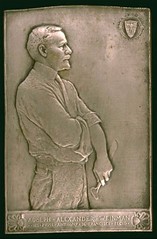 One of the earliest known works by de Francisci is a portrait plaque of Alexander Weinman, made in 1915. It features a standing portrait of Weinman against a plain field, based on a 1912 photo. The plaque reads at the bottom in two lines: “ADOLPH ALEXANDER WEINMAN” / HIS PVPIL ANTHONY DE FRANCISCI FECIT”, with fecit being a Latin world meaning “made by” or “made this”. The use of the V instead of the U in “pupil” would be something that de Francisci would continue to use, including on his design for the Peace Dollar.
One of the earliest known works by de Francisci is a portrait plaque of Alexander Weinman, made in 1915. It features a standing portrait of Weinman against a plain field, based on a 1912 photo. The plaque reads at the bottom in two lines: “ADOLPH ALEXANDER WEINMAN” / HIS PVPIL ANTHONY DE FRANCISCI FECIT”, with fecit being a Latin world meaning “made by” or “made this”. The use of the V instead of the U in “pupil” would be something that de Francisci would continue to use, including on his design for the Peace Dollar.
One of the last numismatic items that de Francisci designed was the inaugural medal for the 1964/65 World’s Fair held in New York City. The obverse featured a globe, encircled by a number of lines representing the paths of satellites, with the text “MAN’S ACHIEVEMENTS IN AN EXPANDING UNIVERSE / NEW YORK WORLD’S FAIR”. The reverse featured the coat of arms of the city of New York, the text “300TH ANNIVERSARY OF THE FOUNDING OF THE CITY OF NEW YORK” and the dual dates 1664-1964.
The medal was sold at the fair struck in white metal and enclosed in a small plastic case. They are generally available for a few dollars although examples struck in other metals (such as sterling silver) are noticeably more difficult to find. Other medals that Francisci designed included a 1935 medal for the Society of Medalists, the Texas Ranger Congressional Medal, and two medals for the Hall of Fame of Great Americans medal series. He also designed the National Guard Bureau Insignia.
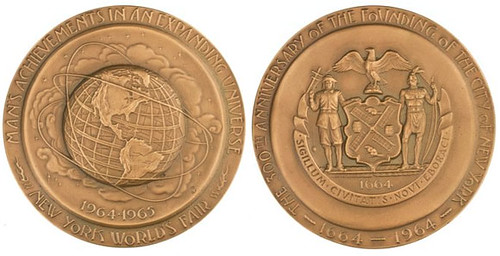
Anthony de Francisci passed away on October 20, 1964. The Peace Dollar will make us forever remember the man, as do the medals he designed. His wife Teresa would live until the age of 92, passing away on the same date as her husband in 1990.
To read the complete article, see: The Life and Work of Anthony de Francisci (news.coinupdate.com/the-life-and-work-of-anthony-de-francisci-3143/)
ON THE LEGALITY OF OWNING ALUMINUM CENTS
 Heritage is offering a 1974-D aluminum cent for sale at public auction to be held at the Central States convention this spring, and though the Mint has in the past (1993) claimed that the coin is government property never released into circulation, the factual, documented arguments have a better chance of prevailing.
Heritage is offering a 1974-D aluminum cent for sale at public auction to be held at the Central States convention this spring, and though the Mint has in the past (1993) claimed that the coin is government property never released into circulation, the factual, documented arguments have a better chance of prevailing.
To consider the crucial issue of why it is probably legal to own an aluminum cent requires an examination into the origin of the coin, its history, and the marshaling of these details to form an opinion. Back in the fall of 1996, I made a formal inquiry under the Freedom of Information Act to the Department of the Treasury for information regarding 1974 and 1975 aluminum cents. (There were aluminum cents minted with the 1974 date, as well as the 1975 date). Some 27 pages of documents, many previously unknown, surfaced.
These included documents from the files of the Office of the Executive Secretariat of the U.S. Mint, as well as office of the Mint historian. The Operations, Policy and Management divisions of the Mint, as well as the Security office of Mint headquarters were also consulted.
In July, 1990, Dr. George E. Hunter, assistant director of the Mint for process and quality control, wrote to an individual (whose name and address was blocked out under FOIA guidelines to insure privacy) that there were 11 of the 1974 aluminum cents that “are still outstanding. The Mint cannot pay a reward for their return: we regard them as our property, illegally issued into circulation.”
Dr. Hunter went on: “we appeal to your sense of justice in returning them to their rightful owner, the U.S. government.” The Mint offered to authenticate the coins, but he added, “if they are illegal, they will be turned over to the U.S. Secret Service for appropriate action.”
The FOIA inquiry, once it is examined at greater length, reveals much more –– right down to the names of the congressmen and aides who received specimens –– and show that the Mint appears in fact to have given up control over the specimens and put them out into the public domain.
Existence of the aluminum cents, conceived in July 1973, and produced in the fall of 1973, was a closely guarded secret. The coins all bore the 1974 date because it was deemed probable that Congress would swiftly approve, and aluminum cents would enter the general circulation pool in the first half of 1974. The patterns or trial strikes, as it were, would thus be indistinguishable.
On Feb. 25, 1974, resident auditor, J.A. (“Jim”) Morgan wrote to the chief of the Mint’s Internal Audit Staff, William Humbert: “these coins must be considered experimental, and as such, must be accounted for by the internal Audit staff.”
Significantly, he noted, “Accounting for coin struck in the Pressroom, even under optimum conditions, is impossible. Counters on the coin presses are inaccurate, and there are too many areas where coins can be lost, either in the machinery itself or the surrounding areas.”
This turns out to be a significant legal admission, because it demonstrates that the Mint never had a handle on the number of coins produced, the number of coins destroyed, or even the number of coins that might have left the Philadelphia Mint.
Morgan then goes on to say that he “concluded that production of a large number of aluminum pennies in the Pressroom would make it probable that some aluminum coins would leave the Mint either by accident, or intent.”
It is obvious that they never did have a handle on how many aluminum were produced, who had them, who kept them, where they went and who acquired them. They differ from many other coins in that they look like coins but aren’t. Not legal tender. Just a pattern.
To read the complete article, see: Aluminum Cents Look Legal to Own (numismaster.com/ta/numis/Article.jsp?ad=article&ArticleId=27606)
Fred Michaelson forwarded this image of an article in the October/November 1910 issue of The Numismatist on the outcome of the Haseltine pattern coin seizure case.
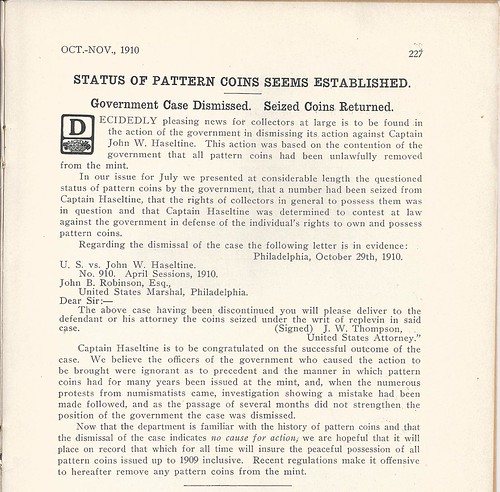
Randy Lawrence was the lucky holder of one very rare, aluminum penny -- and he had no idea.
Lawrence thought it was a 'worthless souvenir,' and it spent more than 30 years in his desk drawer.
The coin, along with a collection of others, had been given to him by his father. In 2013, Lawrence put the coins in the trunk of his car while moving from Denver to La Jolla. Lawrence drove around with them for about a month before deciding to sell them to a local coin shop on a whim.
Michael McConnell, the owner of the coin shop, first suspected the penny was a souvenir from a foreign mint. He later discovered it was actually a 1974-D aluminum penny from the Denver mint.
Only 10 were created and it was previously thought that they were all destroyed.
Realizing that Lawrence had no idea about the penny's origin, McConnell decided to call him to share the good news. They're going to split the profits from the coin's upcoming sale.
To read the complete article, see: A penny inside man's desk drawer could be worth $250K (www.aol.com/article/2014/01/31/a-penny-inside-mans-desk-drawer-could-be-worth-250k/20820718/?ncid)
To read the earlier E-Sylum article, see: MAN CAPTURES UNICORN: 1974-D ALUMINUM CENT (www.coinbooks.org/esylum_v17n05a11.html)
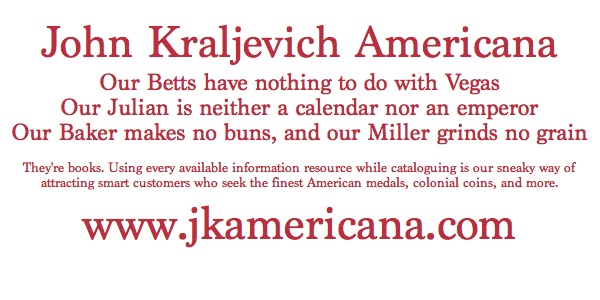
JOHN KLEEBERG ON THE NON-COLLECTIBLE DESIGNATION
The question has been raised as to why other fields of collecting have not adopted the “Noncollectible” designation used in large cents. It should be noted that the NC designation in large cents has had a rather bumpy ride. William H. Sheldon gave the die varieties of large cents minted 1793 through 1814 the numbers 1 through 295, plus 32 varieties that he deemed too rare to collect, which he called “Noncollectible,” or NC. An NC is a variety of which there are fewer than three examples outside the collection of the American Numismatic Society.
This was not the original term; in an early study prepared for Early American Cents in the handwriting of Homer K. Downing, preserved among the Adams collection of papers on large cents at the ANS, the so-called “Noncollectible” varieties are marked with stars or asterisks. The NC designation appeared to solve the classic problem of a die study: How to write a numbering system that would not be thrown out of kilter by the discoveries of additional die marriages. Since any new discovery would be rare, it could just be tacked onto the NC numbering system for each year. Unfortunately, many NC varieties turned out to be quite common; at least one numbered variety, S-79, ended up quite rare; and in at least one case, variety Clapp-Newcomb 34 was originally listed as 1796 NC 6, got delisted, and since has been relisted, but as 1796 NC 7.
Sheldon admitted that it was bold to describe varieties as noncollectible, but he took up the challenge: “it is a courageous or perhaps a foolhardy thing to call a cent ‘noncollectible’ in public print. You then have a thousand or more cent watchers eagerly out for your numismatic scalp. But that is all right: the writer is willing to be fair game. He has had a chance to watch these early cents for several decades and if he has now made bad blunders his numismatic scalp should hang high on the ridgepole.”
As early as the Anderson-Dupont Sale, in 1954, it was clear that Sheldon had not realized how common some of the NC varieties were. In order to retain his numbering system, he decreed that any NC varieties of which more than four were discovered would be renamed “Now Collectible,” and appear as NC but in italic type. He adopted this system in Penny Whimsy, but omitted any mention of his “numismatic scalp,” – because under the terms that he had stated in Early American Cents, it should have been hanging high up on the ridgepole.
For one numbered variety, the S-79 reeded edge, Sheldon knew of five examples, of which one was in the ANS. Del Bland has also seen and graded five examples.
Unfortunately, Alan Brotman cornered the market and then disappeared, taking two examples of S-79 (including Downing’s wonderful brockage that was in the 1952 ANA sale) with him into oblivion. Since one example is in the ANS collection, and another example was in the Naftzger collection from 1972 through 1992, collectors who wanted to complete a numbered set of Sheldon varieties had to trade back and forth the only S-79 in “free circulation.” So the NC system was turned topsy-turvy: There is one variety, S-79, which for many years was de facto unique, but some NCs exist in as many as thirty examples.
1796 NC 6, the stemless wreath of 1796, variety Clapp-Newcomb 34, was included by Sheldon in Early American Cents. Then he decided that it was a fake variety that had been created by tooling and removed it from Penny Whimsy. However, in 1994 Mark Borckardt discovered a half cent overstruck on a cut down 1796 cent that was exactly this variety. Unfortunately another variety had been named 1796 NC 6 in the meantime, so the rehabilitated Clapp-Newcomb 34 had to be named 1796 NC 7 instead.
In short, the NC numbering system has not turned out to work well in practice.
Last week, James Higby wrote:
As I understand the NC designation for large cents, it applies only to the early date die pairs (1793-1814) which were numbered sequentially from 1 to 295 by William Sheldon, leaving no room for new discoveries. NC then originally meant "not catalogued" and the first such discovery coin for a given date was given a designation such as 1793 NC-1.>>
Not exactly. Originally, Sheldon used NC to mean Non-Collectible; i.e., no more than two specimens in "numismatic circulation." When a third example was discovered, Sheldon italicized the "NC" and changed the meaning to "Now Collectible." This latter nomenclature never caught on, and varieties with the NC designation are simply referred to as "NC's".
To read the earlier E-Sylum article, see: NOTES FROM E-SYLUM READERS: FEBRUARY 2, 2014 : More On the Non-Collectible Designation (www.coinbooks.org/esylum_v17n05a10.html)
QUERY: IMAGE OF 1881 SWISS 20 CENTIME SOUGHT
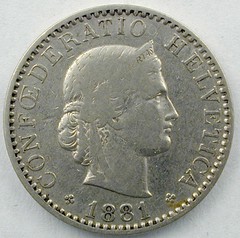
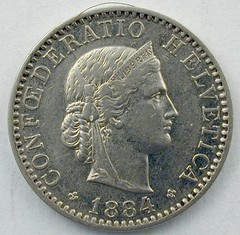
While continuing my numismatic studies, I found a rather obscure reference to a possible hidden image in a coin. The article was presented in the Bulletin de la Société Suisse de Numismatique, 1re année (1882), No. 5, and was reporting on the Essais of the new 20 rappen (centime) coin introduced in 1881, which was the world’s first circulation coin made of pure nickel. The final paragraph tells the story (translated from French by Google and me),
“Newspapers have occupied much of the new 20 cents coin of 1881 about people fancying the head of the Emperor of Germany in the contours formed by the hair of Helvetia. Despite the best intentions, I have not seen anything like this, we must believe that I have very little imagination or rather that others have too much. These people will, I think, the same who took the angel (monetary detail of Brussels, which is the reverse of the coin of 20 francs. in 1871) for the head of Bismarck. It is unfortunate that such absurd remarks are inserted in the newspapers, who have no other result than to mount the imagination of credulous people who read them.”
It is signed by M. de Palézieux, who was the SNS President at the time. Here is the original French for those who want to try their own translation:
Les journaux se sont beaucoup occupés de la nouvelle pièce de 20 centimes 1881, au sujet de personnes croyant voir la tête de l'empereur d'Allemagne dans les contours, formés par les cheveux de l'Helvétie. Malgré la meilleure volonté, je n'ai rien vu de pareil, il faut croire que je possède bien peu d'imagination ou plutôt que d'autres en ont trop. Ces personnes seront, je pense, les mêmes qui ont pris la tête d'ange (point monétaire de Bruxelles, qui se trouve au revers de la pièce de 20 frs. 1871) pour la tête de Bismarck. Il est à déplorer que l'on insère dans les journaux des remarques aussi absurdes, qui n'ont d'autres résultats que de monter l'imagination des personnes trop crédules qui les lissent.
M. de Palézieux erred when he mentioned the head of Helvetia on the coin – it is Libertas as presented on her tiara (a point the article made clear). The German Kaiser in question would have been Frederick III, who ruled until 1888. Personally I cannot see any hint of a face on the coin, but the example in my collection is of such a low grade that it could have rubbed off in circulation. My 1884 coin is in better shape but there is no guarantee that the dies had not been reworked in the intervening years. This coin is so unimportant in the pecking order that I cannot find any high-grade images of it online. If anyone can provide one, please email me at bobfritsch@earthlink.net.
Just another fascinating tidbit from the Wonderful World of Numismatics.

Archives International Auctions, Part XVII
Rare U.S. & Worldwide Banknotes, Scripophily, Security Printing Ephemera, Further Selections From the Hamtramck Collection & Part 1 of the Scarsdale Collection of Modern African Banknotes
Highlights include:
- Lot 102 Banco de Quito. 5 Pesos. 1880. Pick #S242 Unlisted as issued note
- Lot 704 Essay Proof of Merchants National Bank of Chicago - a rare essay proof of original issue national banknote
- Lot 394 Central African Republic, 5000 Francs, P-11
- Lot 837 Crescent Mutual Insurance Co., ca.1850's Specimen Stock Certificate
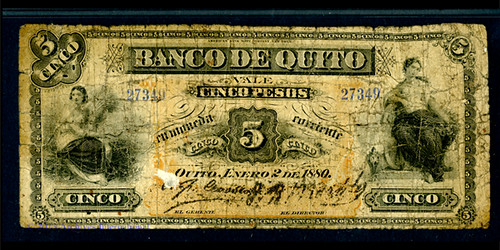
1580 Lemoine Avenue, Suite #7
Fort Lee, NJ 07024
Phone: 201-944-4800
Email: info@archivesinternational.com
WWW.ARCHIVESINTERNATIONAL.COM
FILM: GOLD FEVER AND THE BECHTLER MINT
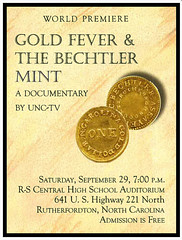 For many it is a surprising story: that North Carolina was the site of America’s first gold rush, and that a German immigrant living in the small mountain town of Rutherfordton in Rutherford County created a successful private mint that produced the first $1 gold coin in American history. Now, a new documentary, Gold Fever and The Bechtler Mint, explores the story of North Carolina’s gold rush and tells how one talented, determined man filled a need and transformed an entire region by changing the economy, and instilling a pride that is still evident to this day.
For many it is a surprising story: that North Carolina was the site of America’s first gold rush, and that a German immigrant living in the small mountain town of Rutherfordton in Rutherford County created a successful private mint that produced the first $1 gold coin in American history. Now, a new documentary, Gold Fever and The Bechtler Mint, explores the story of North Carolina’s gold rush and tells how one talented, determined man filled a need and transformed an entire region by changing the economy, and instilling a pride that is still evident to this day.
The Beginnings Of NC’s Gold Rush
The discovery of a 17-pound gold nugget in Cabarrus County, NC in 1799 marks the beginning the North Carolina Gold Rush. Twelve-year-old Conrad Reed found the treasure in the waters of Little Meadow Creek and took it home where it was used as a doorstop for three years. In 1802, the boy’s father, farmer John Reed, took the rock to a jeweler in Fayetteville who confirmed that it was gold and bought it for $3.50, later profiting a thousandfold.
Reed, soon realizing that he had been swindled, aligned himself with partners in a crude mining operation at the site of his son’s find. The men scoured the banks and sandbars of nearby rivers and streams using picks, shovels, pans and possibly a rudimentary rocker device to separate the heavy gold particles from the lighter sand and debris.
For 20 years following the discovery of gold on Reed’s farm, miners, many of whom were smalltime farmers, sifted through sand and gravel along NC’s streams and rivers. Because surface mining takes only simple equipment, a shovel and pan, or a crude rocker, prospectors came from all across the state as well as from surrounding areas to try their luck and seek their fortune.
Where’s The Gold?
By the early 1820s, the pursuit of gold in NC had become a major enterprise. In 1823, the state appointed Denison Olmsted, a faculty member at the University of North Carolina, as the first state geologist and commissioned him to conduct a geological survey to locate gold deposits and other valuable minerals. First Olmsted, and later German mining engineer Charles E. Rothe and then professor Elisha Mitchell, another faculty member from UNC, identified the main areas where gold occurred in the state. Additionally, Rothe and Mitchell produced reports for the state legislature and the American Journal of Science, fueling further interest in NC’s potential for gold mining.
In 1825, Mattias Barringer, another German whose farm was about 20 miles from the Reed farm, followed a vein of surface gold down to the gold-bearing rock. The Barringer Gold Mining Company was the first of many in the Charlotte area to try deep vein mining. Subsurface mining required far more equipment and technical skill than placer mining. Within a few years, dozens of companies had been formed to work the deeper gold deposits.
The discoveries and excitement continued to mount. Production increased as experienced miners and engineers arrived from European and South American mines. By 1832, more than fifty mines were operating in NC, employing more than 25,000 people. Next to farming, more people were employed in gold mining than in any other enterprise.
In 1837, English geologist George Featherstonhaugh visited several NC gold-mining operations between Rutherford and Mecklenburg Counties. He was distressed by the destruction of the land wherever placer mining was taking place, and observed that heedless removal of topsoil in the quest for gold ruined the land for future agricultural uses.
Problems Facing Miners & Prospectors
Although raw gold was abundant in NC, gold coins were not. Bartering was a common practice during America’s colonial and antebellum periods. The banking system was in chaos. State banks issued and recalled paper currency that was often inadequately backed with real assets. English and Spanish coins continued to circulate in the early 19th century with values that varied from place to place. Gold coins from the U.S. Mint in Philadelphia were rarely found in the South. Even silver and copper coins were rare.
Southern prospectors who were lucky enough to find gold had no reliable market for it. The only U.S. Mint was in Philadelphia - a long, dangerous journey away. There were few roads and fewer bridges. Travel was uncomfortable and unreliable. Much of the gold found by well-organized companies could be shipped through Charleston to Europe more reliably than it could be sent to Philadelphia.
Rutherford County Historian Robin S. Lattimore (who appears in the film) writes:
You may purchase copies of the Bechtler documentary produced by UNC-TV by sending a check for $20 (includes shipping) made payable to the Rutherford County Historical Society.
RCHS
Attn: Robin S. Lattimore
P.O. Box 1044
Rutherfordton, NC 28139
To read the complete article, see: Gold Fever and the Bechtler Mint (goldfever.unctv.org/)
To read the earlier E-Sylum articles, see:
NORTH CAROLINA ORGANIZATION HOPES TO BUY BECHTLER HOUSE
(www.coinbooks.org/esylum_v16n42a11.html)
FEATURED WEB PAGE: VISIT N.C .GOLD
(www.coinbooks.org/esylum_v16n42a29.html)
HARVEY STACK REMEMBERS COLLECTORS DENNIS AND SAMUEL WOLFSON
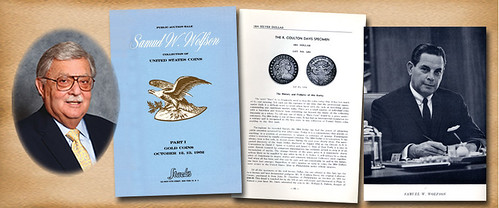
Generally speaking, it was rare for a young collector to encourage his father into collecting. Usually in numismatics, collecting started with a grandfather, passed on to his son, and often the grandson continued the efforts, if he was interested.
But while the older generation usually led the younger, sometimes a young beginning collector could influence a parent or relative.
Such was the case with a young man named Dennis Wolfson. He had spent many a day searching through change that came to his home in the late 1940s and early 1950s. His father, Samuel Wolfson, was a well-known industrialist, during the 1940s-1950s and would travel the country for business. He would usually bring home interesting coins from different U.S. mints that he found in his pocket change. From these, Dennis had the pick of the coins he wanted for his collection. Of course, some of the rare and scarce dates could not be found in change. In the early 1950s, Dennis had his Bar Mitzvah. A portion of the gifts were cash and he asked his Dad to take him to Stack’s in New York, to see if he could use this money first to finish his Lincoln cent collection and then to get coins for some of the other denomination sets he was working on.
So Sam Wolfson took Dennis on his next trip to New York, and they both visited Stack's. Dennis wanted to get the 1909-S V.D.B., the 1914-D, and the 1931-S cents, all of which Stack's had available in various grades. Dennis looked over what we had, trying to match the condition of the pieces already in his collection. Meanwhile his Dad walked about the shop and saw things he was unaware even existed. My cousin, Norman Stack, chatted with Mr. Wolfson and explained collecting to him. Norman answered questions about what was on display, what the items would cost, how values compared from one grade to another, and generally worked with him for an hour. Dennis, once he had his selections, joined to listen more about coins.
After a while Sam Wolfson told us about how searching for coins had brought members of the family closer together. He decided he was going to build a monumental collection. At the time, Stack’s had in the showcases complete sets of small cents, sets of two cents and three cents silver and nickels, Mercury dimes, twenty-cent pieces, Washington quarters, Liberty Walking half dollars, the 144 piece set of U.S. commemorative coins, a set of Peace dollars, a set of Proof trade dollars 1873-83, a set of Indian Head quarter eagles and an 11 piece set of gold commemoratives.
Dennis, who knew a lot more about many of the coins than an average young beginner, helped his father review all the items that were in our showcases. They spent another two hours, with the help of Norman and myself, filling in information about what was shown to them. Sam told us later that he was surprised how much his son knew and how excited Dennis was to explain the coins he knew about but rarely saw. Sam thought that if he started to collect, he could also increase the bond he had with his son and with that goal in mind, Sam decided to acquire all that he saw on display.
After the transaction was completed, Sam set forth a program of expanding his collection, by adding earlier coins, which he knew could not be bought as sets, but had to be acquired individually from over the counter sales, by mail order or by attending some of the great sales Stack's had in the early 1950s. Unfortunately, the elder Mr. Wolfson became very ill and he decided to sell his collection in the early 1960s. Stack's prepared two catalogs of his collection, one for the gold coins and the other for the silver and copper coins. Sam always remembered that first visit to our shop, the information we offered, and the help we gave him in acquiring his collection. He also never forgot how it was Dennis’ interest in numismatics that influenced him to develop an interest in coins and led him to develop such a fine collection.
To read the complete article, see:
How a Young Collector Influenced His Father in Numismatics
(www.stacksbowers.com/NewsMedia/Blogs/TabId/780/ArtMID
/2678/ArticleID/64341/How-a-Young-Collector-Influenced-His-Father-in-Numismatics.aspx)
CANADIAN POLICE SEIZE U.S. BANKNOTE COUNTERFEITING PRESS
 An offset printing press used to manufacture counterfeit US$20 banknotes was seized by the RCMP and US Secret Service. This significant seizure was made earlier today in the Trois-Rivières area. The authorities had been looking for this offset press for several years. A large quantity of paper was also seized by police, that could have been used by the counterfeiters to manufacture from US$40 to US$200 million.
An offset printing press used to manufacture counterfeit US$20 banknotes was seized by the RCMP and US Secret Service. This significant seizure was made earlier today in the Trois-Rivières area. The authorities had been looking for this offset press for several years. A large quantity of paper was also seized by police, that could have been used by the counterfeiters to manufacture from US$40 to US$200 million.
This operation conducted as part of an investigation dubbed Project CRANIUM follows in the wake of the May 2012 dismantling of a laboratory, also in Trois-Rivières, that was used to add finishing touches to counterfeit notes. The investigation showed that the criminal organization had the capability to manufacture and to distribute worldwide millions of counterfeit US$20 banknotes.
Those very high quality counterfeit notes were virtually undetectable to the naked eye. Some of the features they had were rather uncommon in this criminal industry, including the type of paper used, that was especially made with a Jackson watermark and a dark vertical stripe imitating the security thread found in authentic notes.
Back in 2012, four individuals linked to this counterfeiting ring were indicted on a variety of charges, including possession of counterfeit money, making counterfeit money and uttering counterfeit money.
To read the complete article, see: Press Used to Print Millions of Counterfeit US Banknotes Seized (www.rcmp-grc.gc.ca/qc/nouv-news/com-rel/2014/01/140131-eng.htm)
THE BOOK BAZARRE
DICK JOHNSON ON SLABBING HISTORICAL MEDALS
It might be difficult to add any more convincing reasons for not slabbing medals than what Tony Lopez listed in his MCA Advisory article mentioned in last week's E-Sylum. But I would like to add two more reasons -- size and finish.
While medals can be any size, the majority are two inches or more in diameter. Slabs are somewhat limited to 1 1/2-inch, silver dollar size. So-Called Dollars this size COULD be slabbed. But most collectors even of this specialty are sophisticated numismatists who do not appreciate their medals entombed in plastic.
Slabs were invented for several reasons. One was to preserve their surface, to keep human finger oils off the surface where any such chemicals will tone or darken the surface in time. Coins, particularly those of proof surface, should be handled as little as possible, Slabs met this need.
Another reason was to make it easier for non-numismatists -- that is, investors, to acquire rare coins who would not have to care for them other than tossing them in their safe deposit box.
Medals larger than two inches would not fit within standard slab sizes. Thus medals (defined as less the 80mm, about 3 1/16-inch) would require a larger size slab.. And -- heaven forbid -- large medals, medallions, would never fit within this world. Too many people in the field feel, "if it won't fit in a 2x2 envelope, the hell with it!"
This does not offend medal collectors. The person with that thinking would not do well to collect medals, which requires somewhat of a superior intellect to appreciate the history and significance of such numismatic specimens.
As for finish, most historical medals, and certainly all art medals are given a patina finish and afterwards are LACQUERED. They are intended to be touch and handled. Human contact does not affect lacquered medals. There is a tactile thrill indented for such pieces to be handled by humans.
I remember at a Miami numismatic convention someone brought in a blind person on the bourse floor. I gathered up several high relief art medals and handed these to his handler. "Let him feel these," I said. The smile that came over his face was priceless.
Another incident -- I was present in Medallic Art Company's president's office when a plastics salesman wanted to make holders for medals where they could not be touched. He got a lesson in art medals from the president.
So medals of any size are intended to be felt, to be touched, to feel the relief. That's a pleasure the slab collector will never experience.
To read the earlier E-Sylum article, see: SHOULD HISTORICAL MEDALS BE ENCAPSULATED? (www.coinbooks.org/esylum_v17n05a14.html)
BRITISH COUNTERMARKED U.S DOLLARS
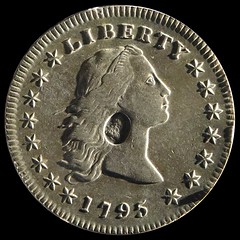
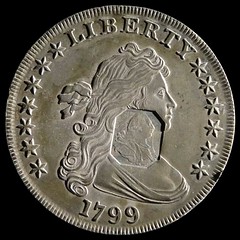
His brother Philip Mernick writes:
The two dollars are on loan from The Bank of England Collection and are on display at the Tower of London’s Mint Street. Other countermarked dollars from Spanish America and France are also part of that display. The oval countermark was applied in 1799 and the octagonal one in 1804.
For more information on the Royal Mint Museum, see: The Tower of London (www.royalmintmuseum.org.uk/history/the-royal-mint-story/the-tower-of-london/)
To read the earlier E-Sylum article, see: BRITISH COUNTERMARK ON A 1799 BUST DOLLAR (www.coinbooks.org/esylum_v16n49a12.html)
W.L. WARING TOKEN DATED TO EARLY 1860S
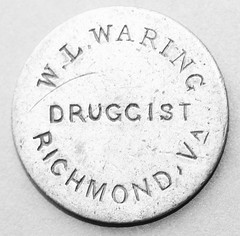
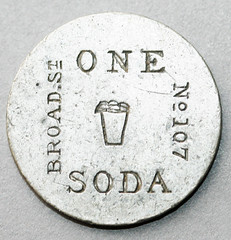
One of my favorite numismatic activities is the monthly Nummis Nova dinner. Started by Wayne Homren a few years ago, this informal “club” is very unusual. There are no officers, no agendas, no dues, and “membership” is by invitation only. We meet at a different restaurant each month, usually in Northern Virginia, and normally have between twelve and fifteen numismatists in attendance. Most of the members bring an item or two to pass around, so it is a wonderful learning experience.
At a recent dinner, I brought the illustrated token and asked each person to estimate its date of issue. Opinions ranged from the 1880s to the early 1900s. The 22mm is struck in lead or white metal, with incuse lettering.
Although extremely rare, the token is well known to collectors. It is listed as number 1203 by Benjamin P. Wright in “American Business Tokens,” which was published between 1898 and 1901 in the pages of The Numismatist. I listed the token in the catalog I compiled of Virginia tokens, which was published in 1980. At the time I had no information concerning. W. L. Waring, but assumed it was struck in the late nineteenth century.
Learning that you are way off base can be a very humbling experience, and especially so when you consider yourself knowledgeable on the subject matter. A few years after Virginia Tokens was published I was leafing through a copy of Edward Cogan’s sale of September, 1863, and there it was; a listing of the Waring token. An examination of some early Richmond city directories revealed that in the late 1850s W. L. Waring and James Pearce went in business as druggists and chemists, at 107 Broad Street. The two men severed their partnership shortly thereafter, and the 1860 directory shows them operating separate drug stores on Broad Street. Waring remained at the 107 Broad Street address shown on his token.
One of our newer Nummis Nova members, Aaron Packard, is an avid token collector and a really talented researcher. After seeing the token, he put his skills to work and soon sent me three newspaper advertisements that he uncovered. The earliest is for “Waring and Pierce, Druggists, Corner 4th and Broad sts.” It appeared in the July 25, 1857 Richmond Daily Dispatch, and advised readers that “the best Soda Water, furnished icy cold, made of the purest materials, and the largest assortment of Syrups in the city, can be found at our establishment.” It ends by stating that “our price is 6c a glass, or $1 per box of 20 tickets”
The use of the word “tickets” is interesting. It could refer to cardboard chits, or possibly an even earlier token that was used by the partnership. We may never know.
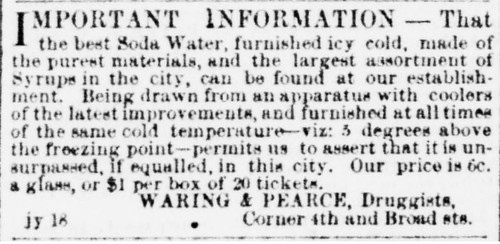
Based on the information above, it seems safe to assume that Waring’s token was issued no earlier than about 1860. Thanks to the listing in the Cogan sale catalog, we know it couldn’t have been issued after 1863. And, the newspaper ads indicate that Waring wasn’t in business after 1861. Quite possibly this is the only legitimate Civil War token from the State of Virginia. Even if it was struck prior to the onset of the war in 1861, it almost certainly would have been in use during its early days.
For more information on the American Numismatic Association, see: www.money.org

THE AMERICAN LEGION SCHOOL AWARDS
1921: Thomas Evans, a member of the State Americanism Commission conceived of a medal to be awarded to boys and girls somewhat along the line of the award provided for in the will of Cecil Rhodes. At the next state convention in Pittsburgh of the Pennsylvania Department of the American Legion, the plan was approved for an American Legion School Award to go to the best all-around boy in the graduating class of every grammar school in Pennsylvania where there were ten or more boys in the competition. Dr. R. Tait McKenzie, noted sculptor and WWI veteran, then head of the Department of Physical Education at the University of Pennsylvania, was commissioned to design the medal. "After many suggestions and conflicting ideas he produced the beautiful medal which was adopted. To satisfy the Marines, their motto "Semper Fidelis," was placed at the feet of the soldier and sailor." So wrote a contemporary Legionnaire.


It is bronze, 3-inches wide and struck by Medallic Art Company. The legend FOR GOD & COUNTRY are the first four words of the preamble to the American Legion Constitution and the two combatants are seen straddling a war torn French landscape.
1950: The American Legion School Award medal was completely revamped. A new design front and back, One uniform size. This design was applicable for award to either boys or girls. Again in bronze, 2½-inches across from the Medallic Art Company.
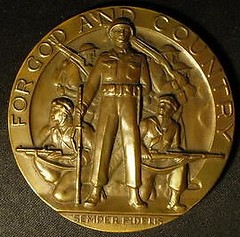
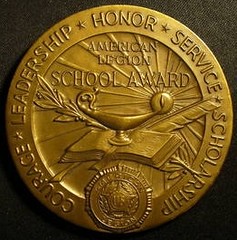
The legend, motto, name and award attributes are the same as the male award from 1922 but the central devices are all new. The military motif on the obverse is now WWII with a soldier, sailor and airman in the foreground with troops in full pack going by behind. At parade rest, on alert and on the march, the medal is all about military preparedness. The reverse has lost the eagle and moved to a central composition of a radiant lamp of knowledge sitting atop an open book above a crossed olive branch and feather pen. A very well thought out design for this award. The sculptor has not been identified but he was certainly talented and skillful. The sculptor Paul Fjelde (1892-1984) has been suggested but further research is required.
1973: The next American Legion School Award looked like this:
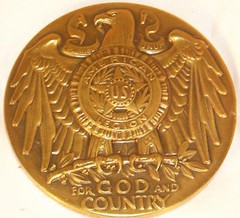
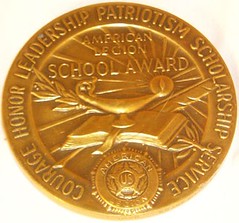
This time the eagle has landed back on the front of this 2½-inch bronze medal and SEMPER FEDELIS the marine motto in exergue has slipped away. The 1963 reverse is continued and this is the medal in use today. It was struck by Medallic Art Company. This is a much more generic School Award medal that emphatically states 'American Legion' without any other editorial.
TURKEY COUNTERSTAMP ON A FRANKLIN HALF DOLLAR

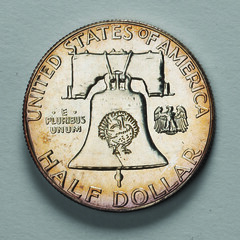
Some issues back, over several issues of The E-Sylum, I recall there were a number of notes from readers with commentaries on turkeys on coins. I picked up a counterstamped piece which is certainly a bit off-beat last fall, which is illustrated in an article of mine in the February 18, 2014 issue of Numismatic News.
Therein was carried a description of the piece:
“While I picked up this piece, a nicely toned proof 1963 Franklin half bearing a ‘turkey’ imprint nicely centered on the Liberty Bell – from Michigan Yooper dealer Jerry Jaeger from Bessemer, who had a table at the Nicolet Coin Club show in Green Bay about 10 days earlier – for illustrative purposes I feel it is a better fit here.
“I suppose I will never know the who, why or how many were similarly counterstamped.
“Obviously, the person must have been an appreciator of Ben Franklin’s having favored the turkey over the eagle as the country’s avian symbol and that Franklin had been supplanted by Kennedy on the half-dollar in1964.”
To read the earlier E-Sylum articles, see:
QUERY: NUMISMATIC ITEMS PICTURING TURKEYS SOUGHT
(www.coinbooks.org/esylum_v16n51a24.html)
MORE TURKEYS IN NUMISMATICS
(www.coinbooks.org/esylum_v16n52a23.html)
STILL MORE TURKEYS IN NUMISMATICS
(www.coinbooks.org/esylum_v16n53a19.html)
THE BOOK BAZARRE
HERITAGE TO SELL RUTH HILL BANKNOTES
Robert Bethea writes:
You had a very nice article where some of the world paper money magnates discussed the status of the Ruth Hill Collection. In short, Dusty Royer said the bank still has it.
Did you see the upcoming highlights for the Central States Numismatic Society auction by Heritage? They list as part of the sale "The Ruth W. Hill Collection" and let's just say some of the notes they've highlighted are nothing short of spectacular.
Iran Imperial Bank of Persia 20 Tomans
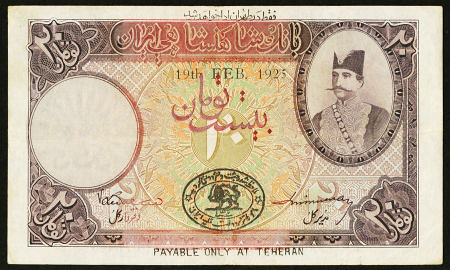
To view the complete lot description, see: Iran Imperial Bank of Persia 20 Tomans 19.2.1925 (currency.ha.com/c/item.zx?saleNo=3525&lotIdNo=17030)
French West Africa 1000 Francs
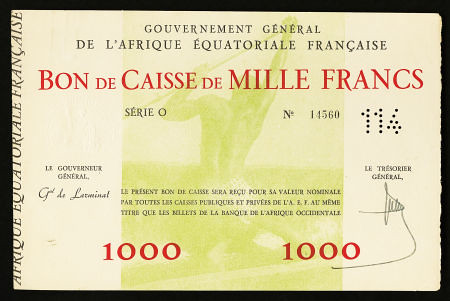
To view the complete lot description, see: French West Africa 1000 Francs 22.11.1940 (currency.ha.com/c/item.zx?saleNo=3525&lotIdNo=17067)
Straits Settlements 100 Dollars
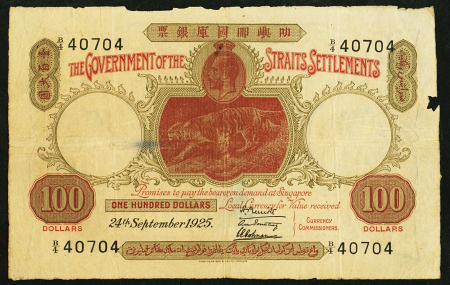
To view the complete lot description, see: Straits Settlements 100 Dollars 24.9.1925 Pick 13 (currency.ha.com/c/item.zx?saleNo=3525&lotIdNo=17083)
Gilbert and Ellice Islands £1
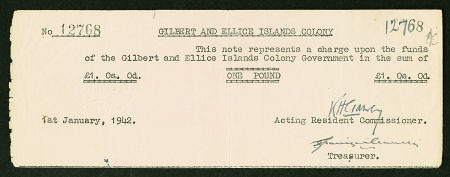
To view the complete lot description, see: Gilbert and Ellice Islands £1 1.1.1942 Pick 5. (currency.ha.com/c/item.zx?saleNo=3525&lotIdNo=17051)
Iraq Government 100 Dinars
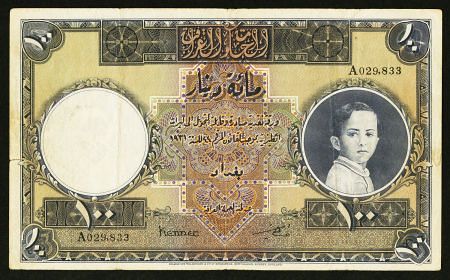
To view the complete lot description, see: Iraq Government 100 Dinars L.1931 (1942) Pick 21 (currency.ha.com/c/item.zx?saleNo=3525&lotIdNo=17033)
Fiji Treasury 10 Dollars
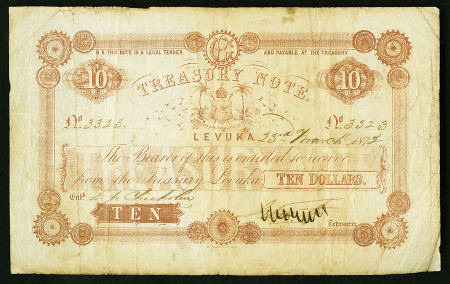
To view the complete lot description, see: Fiji Treasury 10 Dollars 23.3.1872 Pick 16b. (currency.ha.com/c/item.zx?saleNo=3525&lotIdNo=17057)
To view the Ruth Hill collection lots, see: currency.ha.com/c/search-results.zx?N=56+792+4294951762&ic=hero-currency-RuthHillCollection-viewLots-auction3525-020614
To read the earlier E-Sylum articles, see:
QUERY: WHERE IS THE RUTH HILL WORLD PAPER MONEY COLLECTION?
(www.coinbooks.org/esylum_v16n07a16.html)
MORE ON THE RUTH HILL WORLD BANKNOTE COLLECTION
(www.coinbooks.org/esylum_v16n08a07.html)
MONEY ARTIST BRAD TROEMEL EXHIBITION
Andrew Hurle writes:
Readers may be interested in the subject of an exhibition by an American artist named Brad Troemel held at the Future Gallery in Berlin, Germany.
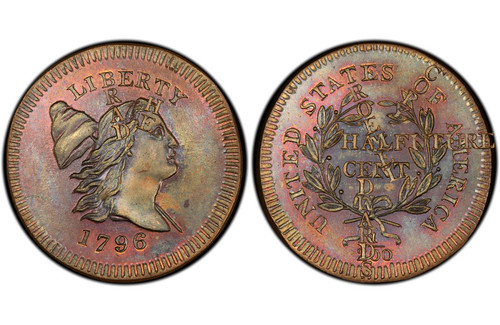
From the web site:
Future Gallery is proud to present The Edwards Copy, 1796 – 2014 a solo exhibition of new work by American-artist Brad Troemel.
From the years 1994 – 1999 I collected rare American coins and paper bills with my Grandpa. I used eBay to buy and sell counterfeit and authentic currencies produced during American colonial times and the Civil War.
Did you know some people buy counterfeit currency on purpose? When a counterfeit is old, notorious, or done well enough, the historical value of the counterfeiter’s effort can meet or exceed the price of a United States’ Mint-produced coin or bill of the same date. Just like originals, counterfeits have histories too. All currencies -real and fake- eventually lose their exchangeability as money and become a collectable over time. You couldn’t spend an 1836 half cent at a store if you tried. Some counterfeits are made for historically illustrative purposes, displaying in perfect detail what money looked like hundreds of years ago. These educational counterfeits are branded COPY or FACSIMILE in very obvious ways. Unlike these, most counterfeits are attempts to appear real.
When I made counterfeits to be sold on eBay I would try to blend in too, to be real. I would purchase educational counterfeits of colonial coins that were independently made in the 1780’s (prior to the Coinage Act of 1792 and subsequent creation of the Philadelphia mint). The first task would be to go to my driveway and use a brick to wear the coin down far enough so that the stamped COPY indentation was no longer visible. Next would be the chemical baths, alternating between Deller’s Darkener and a pencil eraser or EZ Brite, occasionally stopping between pourings to give the coin a few additional brick scuffs so to add layers of deepening chemical damage in an attempt to falsify the gradual process of copper’s deterioration. The chemical baths create an effect on the details of the coin not unlike if you were to alternately burn and dodge an image back and forth using Photoshop.
These near-anonymous coins, in a deep state of wear and chemical damage, were barely legible save for a few defining details (I usually made sure at least the coin’s date remained intact). I sold batches of three or so of these coins at a time, with the auctions spread at least a month apart. All listings worked from an elaborate descriptive template where I said the coins were repossessed from the home of a dead Italian mobster and that due to the great deal of wear and tear they display it’s impossible to determine their authenticity, though it’s safe to assume the coins have a “dubious” provenance.
At the end of the eBay description I would assure my faked obliviousness as a seller by professing to know nothing about coin history and restate that the coins were for sale “as is” because of my lack of knowledge. This would keep the door open for the hopeful who thought there was an outside chance of me being a rube and the coins being real, while for others the disclaimer would add an air of mystery as to what mob family counterfeited them and how many others were out there. My collectors were buying into a story and were receiving coins in exchange. My collectors were people interested in telling tales about the things in their collections. Marketable things can be fit into concise oral descriptions- like conceptual artworks!
His eBay scams aside though, I think the Troemel's work as displayed here is legitimate and fully within the theme of modern "money artists" like J.S.G. Boggs. He discusses the Casascius Bitcoins and uses them in his work, along with other items we've discussed here in The E-Sylum, including NORFED coins and time-based community currencies. -Editor
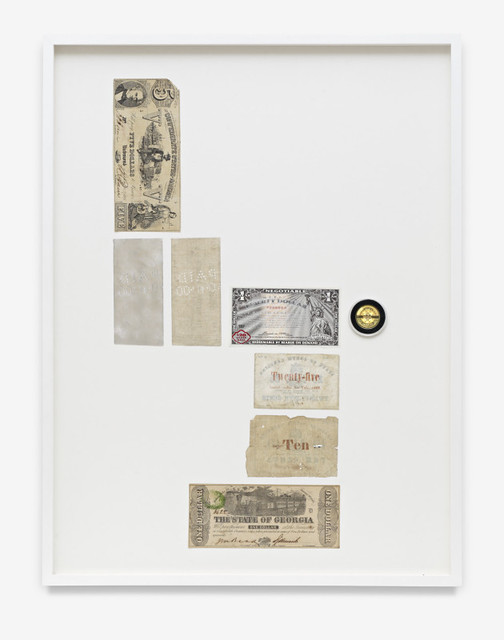
To view the complete gallery online, see: Brad Troemel The Edwards Copy, 1796 – 2014 February 1 – 28, 2014 (futuregallery.org/present/brad-troemel-the-edwards-copy-1796-2014/)
FEATURED WEB PAGE: UNITED STATES ASSAY COMMISSION MEDALS
This week's Featured Web Page is a collection of images of silver U.S. Assay Commission medals.
Assay Medals were struck from 1860 to 1977. Metals included Copper, Silver, Aluminum, White Metal, Pewter and a single gold medal.
The "AC" number classification was introduced by Julian and Keusch in an article in the Token and Medal Society Journal 29:5(2) (1989).
All silver Assay Medals are RARE with distribution limited to fewer than 55 pieces for any given year.
The list below includes only years in which Julian indicates at least one piece struck in silver.
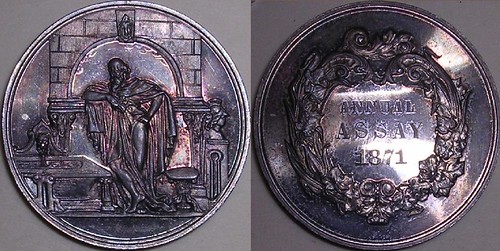
exonumismatics.com/assay/assay.htm
